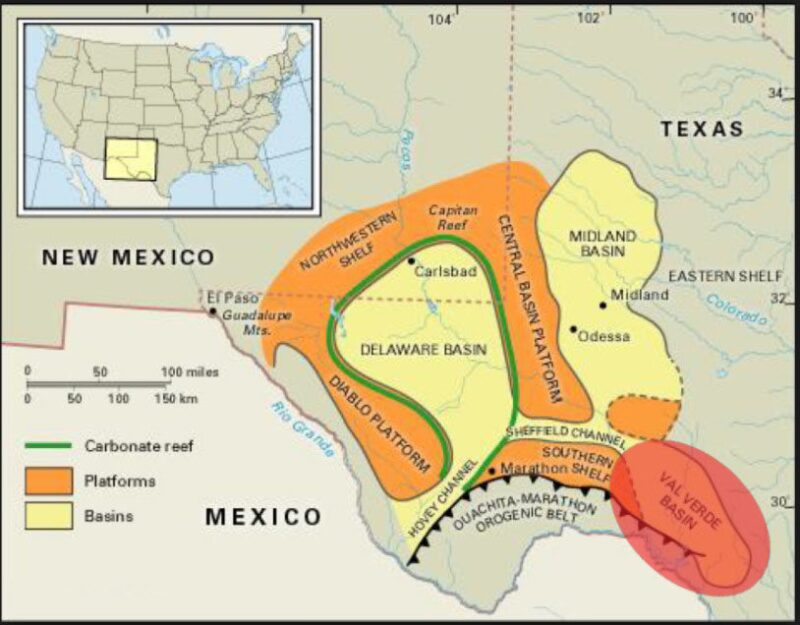The Permian Basin has been the center of United States unconventional oil activity in the last several years, and the center of that play is now shifting to the Delaware subbasin. Jeff Sieler, a managing director in the global energy group at Citigroup Investment Bank, gave a broad view of how and why this has happened in a presentation recently to the SPE Gulf Coast Section reservoir group titled “What Makes the Delaware Tick?”
“Everything is going right there,” Sieler said. “The deal velocity is going fast. The well results that we hear coming out of there are spectacular. The economics associated with that are great.”
Sieler confined his discussion to the Permian geologic sections of the Delaware, particularly the Wolfcamp, Bone Spring, and Delaware Mountain group, noting that other huge petroleum systems also lie beneath them.
‘Pretty Spectacular Numbers’
He noted that for the Delaware Wolfcamp and Bone Spring alone, the projections are that they will reach a combined cumulative total production of 1.4 million bbl of crude oil by the end of the year. “That’s just from those two headline formations,” Sieler said. “And then we look at some pretty spectacular numbers as we get out to 2027,” by which time the two formations are projected to reach 4.5 million bbl of cumulative production.
Optimism about the Delaware is abundantly evident in the valuation of land deals there. Sieler focused on the timeline for the upswing in Delaware acreage transactions and values.
As a comparison, he pointed to the acreage valuations in the Permian’s Midland subbasin just to the east, before the collapse in oil prices. At a price of $90/bbl in the first half of 2014, oil acreage in the Midland was leasing at $30,000 per acre. But as the oil price declined through 2015 and land transactions generally slowed down, the number of transactions in the Delaware sharply increased.
The Industry’s ‘Big Bets’
“The industry figures it out ... to the point where they’re willing to make some pretty big bets,” Sieler said. By December 2015, Delaware acreage began transacting at multiples “every bit as robust as the Midland Basin,” and by the first quarter of 2017, “the Delaware dominated the transaction space,” he said. “So [we see] an adjusted acreage value of $30,000-plus.”
“The Wolfcamp is the most drilled formation in the United States today,” Sieler continued. “The Delaware Wolfcamp is the most drilled Wolfcamp formation.”
There are 140 to 150 drilling rigs operating in the Delaware Wolfcamp at present, compared with approximately 80 in the Midland Wolfcamp. “So contrast that with the complete Eagle Ford [Shale]—75 rigs, something like that?” he said. “The Eagle Ford’s got some outstanding economics as well. But the industry’s talking about bulk volume development, and the Delaware’s winning out.”
Selected Study Area
Given the vast scale of the Delaware, Sieler said that Citigroup has studied a selected area within it comprising the Upper Wolfcamp and third Bone Spring formations. Crude production from the study area has grown from 60,000 B/D in 2014 to more than 300,000 B/D at the end of 2017.
“Now keep in mind what took place during this time,” Sieler said. “The price of oil dropped from $90 a barrel to $40 a barrel, and the more I think about it, $28.” Based on the productivity evidence within the study area, he said, “I can tell you the story is far from over. It’s far from over from the perspective of how completions are being developed.”
Volumetric calculations with industry-accepted methods have estimated totals of 150 million to 350 million bbl of oil in place per 640-acre section. “That is a stunning number,” Sieler said, adding that 60 million bbl would be considered a good figure for the same-sized section in the Eagle Ford’s Karnes Trough or in Oklahoma’s Meramec/Woodford play.
“I’m only talking about the Upper Wolfcamp and the Bone Spring 3,” he said. “So I’ve left a huge stratigraphic section out above it and a massive stratigraphic section out below it.”
‘A Massive Number’
Making a conservative recovery estimate, Sieler said, “We’re coming up with numbers around 45 billion barrels recoverable in that section alone. Now even if we’re wrong by a factor of two, it’s 22 billion barrels. That’s a massive number.”
Sieler also discussed the area surrounding Apache’s large 2016 Alpine High discovery in Reeves County and generally agreed with the encouraging outlooks published about the development of the area.
Overall, for the Delaware subbasin as a whole, the addition of midstream takeaway capacity is critical for future development. Sieler said the indications are that the midstream sector is keeping up with the basin development but will be pushed to maintain a tight schedule for forecast projects to go on stream in coming years. From 80% to 90% of Delaware production travels outward through facilities in the Midland subbasin.

